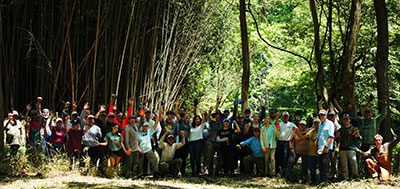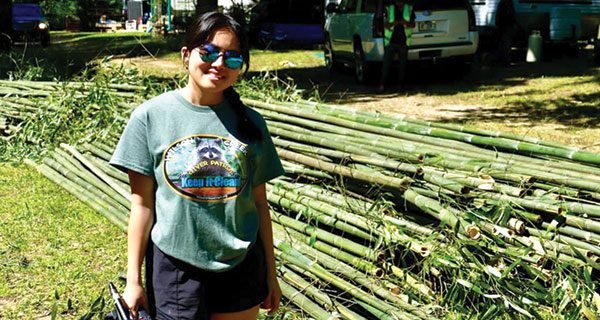This project started over 3 to 4 years ago as Jim Mabrey – former NC State TU Chair, Squeak Smith – recipient of 5 NC Governors awards and Former Chair of Resource Institute, Wes Waugh, Director, A Clean Wilson Creek and Shea Tuberty, Biology Dept. at App State and I sat down with property owner Carla Brinker, to discuss the bamboo and the potential damage it was causing to the campground and to the River. Carla and John Brinker, of Wilmington NC had recently purchased and renamed the former Killians Camp to Wilson Creek Preserve.
Getting these particular people together, most who had never met, was the easiest part of the entire project. These people are all very conservation minded and are or have been involved with Wilson Creek in one way or another for years. Covid was in its infancy and things quickly stalled. Besides, everyone knew that this was going to be a big undertaking and where to begin and what would or could be successful, we just wasn’t sure. So many things came into play.
Over the next couple of years Jim and a couple other campers experimented with possible scenarios that could be useful. Also, during that time the stand of Bamboo became bigger and more daunting. It had grown to a point where during flood stage the bamboo was so dense that it actually held back the river causing it to split into two sections to go around the bamboo patch. The top part of the river, closer to the main road dug a hole about 30 ft long and 20 ft deep and washed that soil into the river. As you know, dangerous river floods are possible and do happen along Wilson Creek which is the major tributary runoff for Grandfather Mountain.

Wilson Creek is a National Wild and Scenic River with a rich history that deserves to be cared for and loved not just used. To use heavy equipment to dig up the roots would leave that newly turned soil vulnerable to wash away. It took 6 months of work and planning to put this current project back into the spotlight and build a plan that we hoped would work.
Saturday, June 8th we had over 50 volunteers from many organizations show up and work together to make a difference. Hickory Trout Unlimited was given $1000 in matching funds for our spending $1000 for expenses for the project by the North Carolina TU Council.
Brian Esque, current NC TU Chair, attended and worked hard for the project.
Our concept was to cut the bamboo within an inch or so from the ground and painting a special herbicide on the cut stalks with in one hour’s time. Although it was safe for River use to spray the herbicide, painting actually applies it directly where it’s needed. Our goal was to leave the roots in place because even dead they will still be effective to hold the ground while natural vegetation takes root. So, even though we had high hopes of removing the entire patch, it proved much more difficult than we anticipated. It seems that not only are the roots a tangled mess but the tops, 40 feet in the air, are also tangled together. Over 50 people worked diligently together but we didn’t even get half of the major patch removed. However, we consider our workday a major success.
We now understand that this is sort of like research. We have learned a lot on what methods work best for cutting, for killing and for recycling. We are yet to study the effectiveness of painting the herbicide on the cut stalks but we are hopeful not only for ourselves but others who will follow that we can share our findings. A newly formed company, National Bamboo, was on site working with us for the best way to transport it from the mountain stream to their new mill in Shelby.
All in all this project although not finished offers us great insight into the future. Certain strains should NOT be planted along rivers to hold banks. We have learned lessons on how to cut and what tools to use and much more. We can study the effectiveness of our method for future work. And most importantly, working together as a community of people who are interested in being a part of the solution.
Wilson Creek has long seen hard times in its past, especially with only the bad publicity being in the spotlight. Organizations working together do make a difference and supporting each other will offer a clearer focus for the creek’s future. TU groups from Hickory, Boone (High CountryTU), Morganton (Table Rock TU), Charlotte ( Rocky River TU), Winston Salem (Blue Ridge TU) and Greensboro (Nat Green TU) were accompanied by people from A Clean Wilson Creek, Carolina Land and Lakes and Foothills Conservancy. We had people drive for up to 3 and 4 hours away just to join us. Also, I want to acknowledge the campers, our families and friends. To one and all, we want to say thank you so much for all your hard work, for coming so far and for loving our Wilson Creek as much as we do.
Our biggest lesson learned is simply, TOGETHER IS THE ANSWER!
